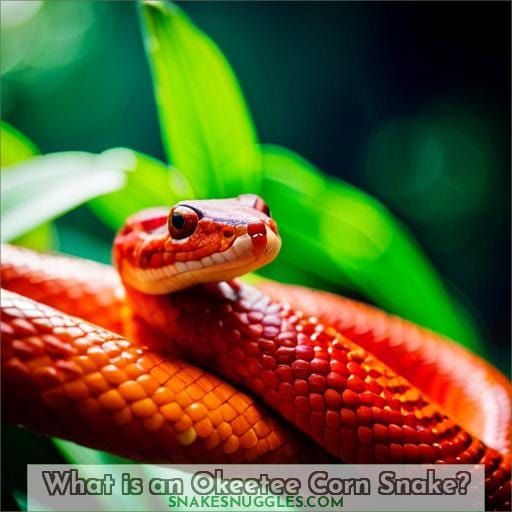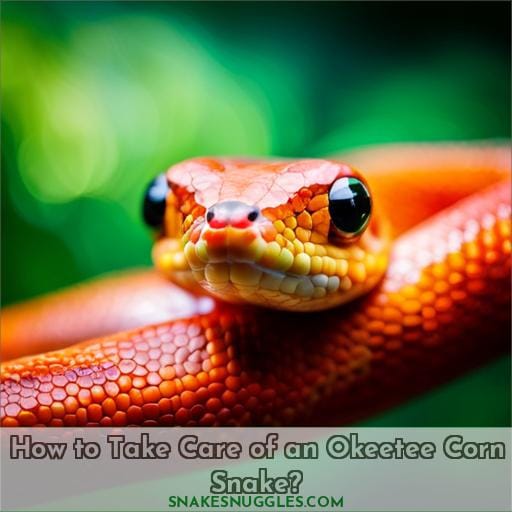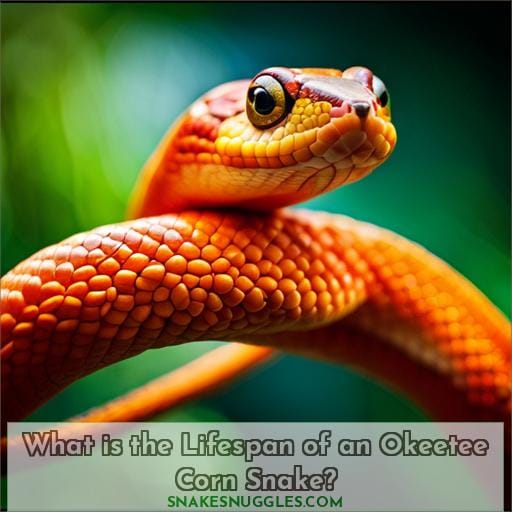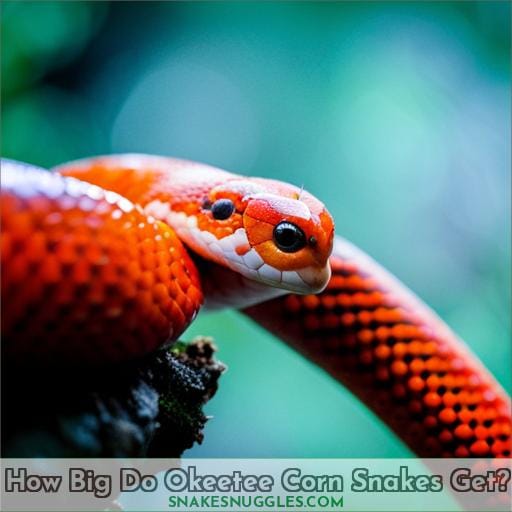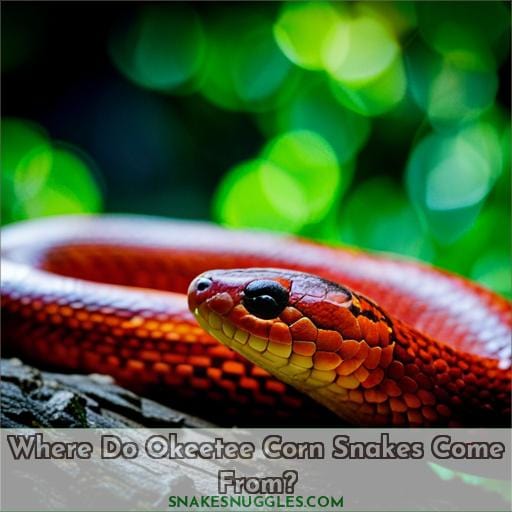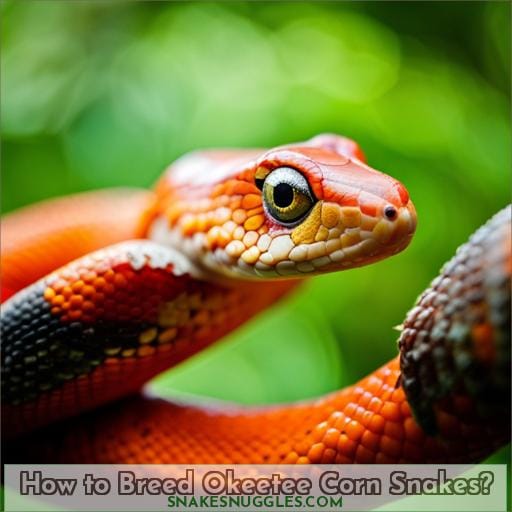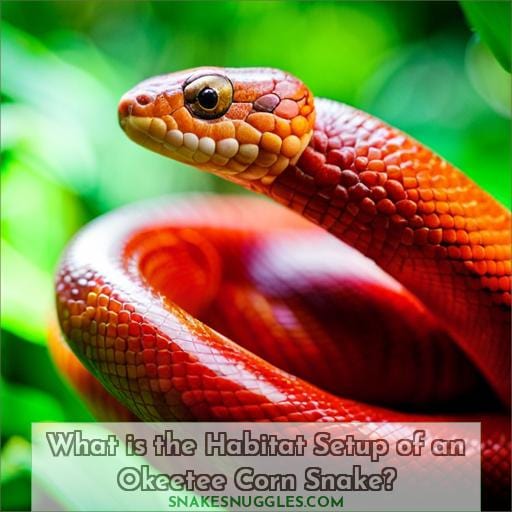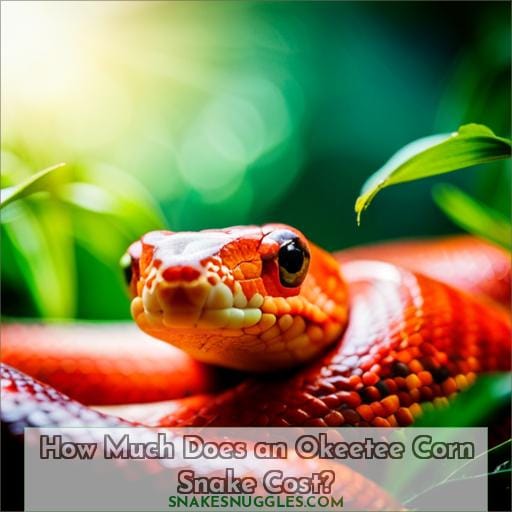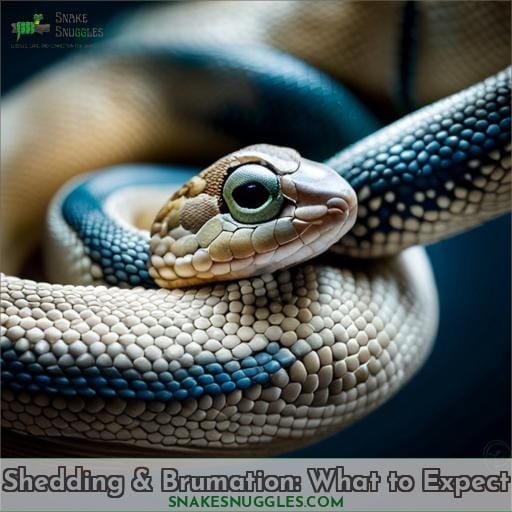This site is supported by our readers. We may earn a commission, at no cost to you, if you purchase through links.
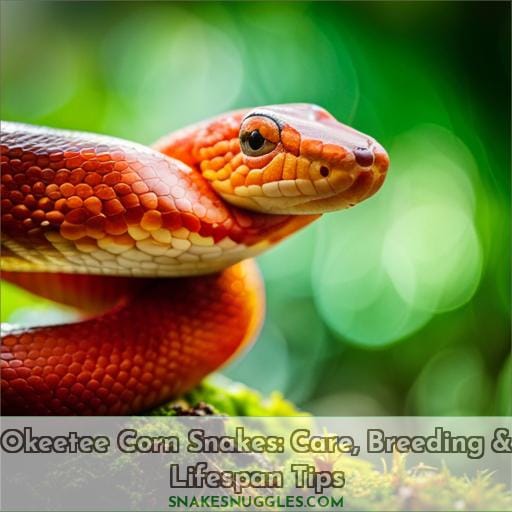 Are you looking for a unique pet snake? Look no further than the Okeetee corn snake. With over 800 different morphs, this is one of the most popular ones and can be found in many homes across the U.
Are you looking for a unique pet snake? Look no further than the Okeetee corn snake. With over 800 different morphs, this is one of the most popular ones and can be found in many homes across the U.
Table Of Contents
- Key Takeaways
- What is an Okeetee Corn Snake?
- How to Take Care of an Okeetee Corn Snake?
- What is the Lifespan of an Okeetee Corn Snake?
- How Big Do Okeetee Corn Snakes Get?
- Where Do Okeetee Corn Snakes Come From?
- How to Breed Okeetee Corn Snakes?
- What is the Habitat Setup of an Okeetee Corn Snake?
- Are There Common Health Issues in Okeetee Corn Snakes?
- How Much Does an Okeetee Corn Snake Cost?
- Shedding & Brumation: What to Expect
- Frequently Asked Questions (FAQs)
- Conclusion
Key Takeaways
- Okeetee corn snakes are native to the southeastern parts of the U.S.
- They have over 800 different morphs, with vibrant colors and bold patterns.
- They require specific tank conditions, including lighting, temperature zones, and substrate type.
- Feeding them a diet of frozen mice or rats is essential for their health.
What is an Okeetee Corn Snake?
You’ll be captivated by the vibrant colors and bold pattern of this beautiful North American rat snake, which is sure to make a stunning addition to your collection. Okeetee Corn Snakes are part of the Elaphe guttata species, also known as Pantherophis guttata guttata.
They range from 2-6 feet in length and have an average weight of 500-750g at 5 feet long, with females being shorter than males. These snakes have deep red dorsal saddle marks that are even more intense than regular corn snakes, with backgrounds varying from bright orange to yellow depending on their morphs.
The pattern features thicker black bands around their saddles, which stand out against their background color, making them easily recognizable among other corn snake morphs like Kathy Love Okeetees or Abbotts Okeeties.
In captivity, they can live for over 15 years, providing they’re kept in an enclosure between 78°F – 82°F with 65%-75% humidity levels. They should be fed frozen mice every 7-14 days and handled properly during shedding times or breeding season.
Mating habits should be observed carefully due to different gene combinations determining morph varieties expressed through offspring’s patterns/colors, etcetera.
With proper care, these stunning creatures will surely become beloved pets!
How to Take Care of an Okeetee Corn Snake?
Taking care of an Okeetee Corn Snake is a rewarding experience, but it requires dedication and knowledge. These unique snakes are native to southeastern parts of the U.S., so their habitat needs to be recreated in captivity.
They require specific tank conditions such as lighting, temperature zones, humidity levels, and substrate type for optimal health. Additionally, they need a diet that consists primarily of frozen mice or rats, with appropriate amounts depending on age and size.
Handling should only take place when necessary due to their generally skittish natures.
With the right setup and proper care, your Okeetee will live a long and healthy life!
Habitat, Tank Conditions & Setup
To provide a healthy environment for your Okeetee corn snake, you need to replicate its natural habitat in captivity by providing the correct tank conditions and setup.
An appropriate enclosure should be at least as long as the snake with half its length in width and height.
Temperature-wise, there should be general temperatures of 78°F – 82°F, cool areas at 75°F, and warm/basking areas at 90°F.
Aspen shavings or cypress mulch make suitable substrates that facilitate shedding when necessary.
Feeding habits depend on size: juveniles should be fed once every 7-10 days, while adults should be fed every 10–14 days.
Cleanliness is key to maintaining health, so keep an eye out for signs like diarrhea or vomiting, etc.
Feeding and Diet
Feeding your Okeetee corn snake is an important part of keeping them healthy. They should be fed every 7 to 14 days and enjoy a diet of mice or rats. It’s best to feed frozen, but thawed mice once every five to seven days, depending on the size and age of your snake.
To provide the necessary nutrition, you can offer fresh water in addition to the food sources mentioned previously for hydration purposes.
Additionally, it is essential that you closely monitor their feeding habits. Overfeeding may lead to potential health problems like obesity.
Handling and Temperament
You can bond with your Okeetee corn snake and make it a part of your family, as they are known for their friendly nature and love to be handled. To ensure safe handling practices, provide an enclosure that is secure from predators while controlling humidity levels, heat source, and food choices.
Ensure the health of the snake by regular veterinary checks as well as observing its behavior inside its environment. Start taming gradually by allowing the animal to get used to you before offering food or interacting directly with them in any way.
As long as you practice safe handling techniques while following all necessary care guidelines for temperature control and nutrition requirements, your Okeetee corn snake will thrive in captivity under proper care!
What is the Lifespan of an Okeetee Corn Snake?
Now that you know how to take care of an Okeetee Corn Snake, let’s discuss its lifespan.
On average, these snakes live for 15-20 years in captivity when provided with proper care and nutrition. In some cases, they can even reach up to 30 years! The growth rate varies depending on the morph and availability of food.
Additionally, their temperament is usually quite friendly once tamed through regular handling sessions. However, breeding requirements must be met before attempting it as predicting the appearance of offspring is difficult without a basic understanding of genetics.
Shedding problems are also common due to their fast growth rate, and they should be monitored closely during this time period to ensure there are no complications or infections present.
Morphs such as Kathy Love Okeetees have vibrant reds with thick black banding, whereas Extreme Okeeteess have wider bands which eclipse the color underneath them, making them exceptionally beautiful creatures both in the wild and captivity alike! Although rarer morphs cost more than common ones do (around $600), okee corn snake owners will undoubtedly agree that owning one is a highly rewarding experience worth every penny spent!
How Big Do Okeetee Corn Snakes Get?
Okeetee corn snakes are an impressive species of North American rat snake, growing to a size between 61 and 182 cm in length. On average, they weigh around 500-750 g when fully grown. With the right care and handling, these beautiful creatures make excellent pets for reptile enthusiasts due to their attractive patterns and friendly nature.
Growth Rate and Size
At maturity, these beautiful snakes can reach lengths of up to 6 feet and weigh around 500-750 grams. Okeetee corn snakes have a moderate growth rate, and when they’re young, they should be fed once every 7-10 days.
Adults should only require feeding every 10-14 days. Genetic inheritance plays an important role in the size of an Okeetee corn snake, with certain morphs being bred to produce larger specimens than others.
Breeding requirements for Okeetees include at least one parent carrying a dominant gene or both parents having recessive genes.
The tail will usually make up almost half their length, but some individuals may grow longer or shorter tails depending on breed characteristics and genetics passed down from their parents. On average, though, most adult males range from 4 to 5 feet long, while females typically measure 3 to 4 feet, weighing between 1 to 2 pounds as adults.
Average Weight
On average, Okeetee corn snakes weigh between 500 and 750g when they are 5 feet long. Selectively bred from wild North American rat snakes originating in South Carolina, they are popular pet snakes due to their vibrant color lines and morphs.
Shedding every 3 months, these beautiful creatures have been selectively bred for size over the years, with brumation aiding their growth rate.
Where Do Okeetee Corn Snakes Come From?
You may have seen the unique Okeetee corn snake pattern with its bright oranges and reds, but did you know that these morphs come from a specific place? The wild ancestor of this popular pet can be found in South Carolina.
It is part of the Elaphe guttata guttata species, also known as Pantherophis guttata. Its habitat consists mostly of forests, overgrown fields, and abandoned buildings where it hunts small rodents such as mice and rats.
There are many different morph types available for purchase today. Kathy Love Okeetees have vibrant reds and oranges with thick black banding. Abbotts produce smoother saddle shapes. Extreme variants feature wider bands which completely eclipse color underneath.
Tessera has broken up patterns featuring vivid colors while Reverse Okeetee albinos show an expanded black band around their dark patterning. Color lines include Red or Yellow depending on background hue while Buckskin features brick-red saddles set against tan tones.
With proper care, they can live up to 20 years in captivity due to their long lifespan.
How to Breed Okeetee Corn Snakes?
If you’re considering breeding Okeetee corn snakes, there are several factors to keep in mind. Breeding requires proper care and knowledge of genetics to predict the appearance of offspring; it also comes with its own unique set of challenges.
By understanding these key points, you can successfully breed this popular morph.
Breeding Requirements and Challenges
It can be challenging to successfully breed Okeetee corn snakes, as predicting the appearance of offspring is difficult without a basic understanding of genetics. To ensure success, choose morphs carefully. Maintain temperature gradients. Provide separate containers for breeding and feeding.
Provide a basking area with temperatures up to 90°F. Use cypress mulch or aspen shavings for substrates. Diet requirements include mice, rats, and frozen food items. The shedding process must be monitored closely – each snake sheds every three months.
Predicting Offspring Appearance
Predicting the appearance of your Okeetee corn snake’s offspring can be a complex task, as even experienced breeders may struggle to accurately assess potential results. Breeding genetics are affected by morph availability, dominant genes, and designer snakes.
Morph pricing is also impacted by genetic diversity and traits that will show up in their offspring.
To increase chances for desired outcomes, it’s best to find Okeetees from the original hunt club or other reputable sources with strong lineage information.
The cost of breeding designer morphs varies greatly depending on rarity, but there’s something special in creating a unique snake from scratch!
What is the Habitat Setup of an Okeetee Corn Snake?
An Okeetee Corn Snake requires a specific habitat setup in order to thrive. The enclosure should be at least as long as the snake and half its length in width and height, with lighting that mimics natural day/night cycles for 12 hours a day.
Temperature zones should range from 78-90°F while humidity is best kept between 65%-75%, using substrates such as Aspen shavings or Cypress mulch.
Enclosure Size
When it comes to housing your Okeetee corn snake, make sure that the enclosure is at least as long as the snake and half its length in width and height. This will provide plenty of space for exploring. The tank conditions should include temperature variations.
The general temperatures should be between 78°F and 82°F. There should be a cooler area with a temperature of 75ºF and a warm/basking area with a temperature of 90°F. You will need a reptile water bowl that is large enough for soaking. Additionally, provide some hiding spots such as jumbo mice or logs in a corner of the cage.
The feeding habits of an Okeetee corn snake consist mostly of frozen thawed rodents like rats. Feed them every 10-14 days, depending on their size. It is important to deep clean the enclosures regularly to prevent bacteria build-up.
Proper care is key to keeping an Okeetee corn snake healthy. Maintain humidity levels between 65% and 75%. Give them regular baths and regulate light cycles with 12 hours on and 12 hours off.
Lighting and Temperature
You should provide light that mimics natural day and night cycles, with 12 hours of light a day. Additionally, you should create different temperature zones for the enclosure to keep your pet healthy. The basking spot should be around 90°F, while the cool end can range between 75-78°F.
Heat lamps can cost anywhere from $15-$50 based on wattage needs, so it is important to research this factor before investing in one for your snake’s habitat setup.
At night, temperatures naturally drop. However, if you want more control over this process, LED lights or red bulbs are recommended. These options don’t produce too much heat and allow Johan van der Dussen or black saddles corn snakes time to rest without disruption once per day.
Lastly, deep orange lighting produces an attractive aesthetic effect, which may add value when considering how expensive Okeetee morphs can get!
Humidity and Substrate
Maintaining a proper humidity level of 65%-75% and choosing the right substrate, like aspen shavings or cypress mulch, will help ensure your Okeetee corn snake remains healthy. Regular cleaning is also important to prevent bacteria growth in the enclosure. It is important to keep optimal temperature ranges for basking, cooling off, and shedding cycles.
Make sure to provide adequate heating sources, such as reptile lamps, so that they can thermoregulate properly. Additionally, providing prey items like rodents regularly will keep their diet balanced and fulfill their nutritional needs.
To mimic natural light cycles during day/night times, it’s recommended to set up lights on for around 12 hours per day, according to Niels Kamp’s recommendations. These recommendations are followed by many breeders worldwide when dealing with elaphe guttata guttata morphs, like Abbotts okeetee corn snakes or tessera okeetees morphs, etc.
Are There Common Health Issues in Okeetee Corn Snakes?
It’s important to keep an eye out for common health issues in these vibrant pets, such as diarrhea or vomiting, bubbles from the nose or mouth, open-mouth resting, and restlessness.
Okeetee corn snakes have a unique pattern with bright red dorsal saddle marks and thick black borders around their color. They should be kept with different temperature zones in mind – 78º-82° F general temp; 75° F cool zone; 90° F warm/basking area – along with a humidity of 65%-75%.
In terms of diet variety, they require frozen thawed mice for juveniles, while adults can consume rats too.
Breeding tips include having at least one parent carrying a dominant gene or both parents possessing recessive genes. It is also important to keep track of shedding habits, which occur every 3 months (unless for breeding purposes).
A day-night cycle should also be provided by lighting being on 12 hours per day, mimicking natural daylight cycles, to prevent respiratory infection problems due to stress associated light changes.
As far as genetic traits go, it is essential that you understand them when selecting your breeder so that you don’t end up disappointed when trying to create designer morphs from base morphs like Okeetees!
How Much Does an Okeetee Corn Snake Cost?
The cost of an Okeetee Corn Snake depends on several factors, including the availability and rarity of different morphs. Availability can range from $80 for a basic morph to over $1,000 for rarer variations; however, with a bit of knowledge and research, it is possible to find high-quality specimens at more reasonable prices.
Factors Affecting Price
The price of an Okeetee corn snake is affected by its morph, color, pattern, and bloodline. Morphs such as Kathy Love or Abbotts can cost more than regular Okeetees due to their rarity. Scaleless morphs are also more expensive than those with scales. Color plays a big role in pricing strategies too; bright orange shades attract higher prices, while black buckskins tend to be cheaper.
Genetics are also important when it comes to bloodlines for breeding purposes, and captive care requirements must be taken into consideration when selecting a morph that fits your budget.
Availability of Morphs
You can find over 800 different morphs of Okeetee corn snakes, with rarer morphs costing up to $600. Morph types include Kathy Love Okeetees, Abbotts Okeetees, Extreme Okeebees, and Tesseras with vivid red colorings and bold patterns.
Breeding tips should be followed when it comes to genetics or producing specific lines like Red or Yellow variants. Price variables are also determined by locality morphs such as Buckskin, which have brighter backs than regular corn snakes for better camouflage in their natural hiding places.
Shedding & Brumation: What to Expect
Experience the beauty of nature in your home as you witness your Okeetee shedding its skin and brumating. Shedding is when a snake sheds its old, dull outer layer to reveal new, healthy skin underneath.
This process usually occurs once or twice per year but can vary depending on age and health.
Brumation is a form of hibernation that snakes go through during cold weather periods to conserve energy.
| Phenomenon | Description |
|---|---|
| Shedding | Reveals new healthy skin beneath an outer layer every 1-2 years |
Brumation
A form of hibernation during cool weather with reduced activity & appetite for weeks at a time
Frequently Asked Questions (FAQs)
What do Okeetee Corn Snakes Eat?
Okeetee corn snakes are nocturnal feeders, often hunting small rodents such as mice and rats. They also enjoy lizards, birds, and bats – so a varied diet is key to keeping them healthy and happy.
What are the Different Morphs of Okeetee Corn Snakes?
Okeetee Corn Snakes have over 800 different morphs, including Kathy Love Okeetees with vibrant reds and oranges, Abbotts for a smoother saddle shape, Extreme with wider black banding eclipsing the color underneath, Tessera which is pixelated and vivid in color.
How Often Should Okeetee Corn Snakes Be Fed?
Feed your Okeetee corn snake once a week for juveniles, and every ten to fourteen days for adults. Offer frozen-thawed mice or rats as nutritious meals that will keep them healthy and thriving.
Are Okeetee Corn Snakes Venomous?
No, Okeetee Corn Snakes are not venomous. They lack heat-sensing pits and have round pupils, unlike a copperhead snake, which is often mistaken for them. Instead of using venom to hunt their prey, they use constriction and then swallow it whole.
What is the Difference Between Normal Corn Snakes and Okeetee Corn Snakes?
Okeetee corn snakes are brighter in color with deeper reds than regular corn snakes and have wider black bands around their saddle marks. They also come in a variety of morphs such as Kathy Love and Abbotts, which boast vibrant oranges and thick black banding.
Conclusion
It’s no wonder that Okeetee corn snakes have become a popular choice for many snake enthusiasts. They have eye-catching patterns and a friendly nature, making them an attractive choice for pet owners. With proper care and feeding, these snakes can live up to 20 years or longer in captivity.
Okeetee corn snakes come in a variety of colors and patterns, with different morphs being bred from classic corn snakes. They prefer habitats such as forests, overgrown fields, and abandoned buildings.
They use constriction to kill their prey. Breeding Okeetees can be challenging, and predicting the appearance of offspring is difficult without a basic understanding of genetics.
The cost of Okeetee corn snake morphs can range from around $50 for more common morphs to over $600 for rarer morphs. Whether you’re looking for a pet or a breeder, these snakes are a great choice. With the right care, you can ensure your Okeetee corn snake remains healthy and happy for years to come.

